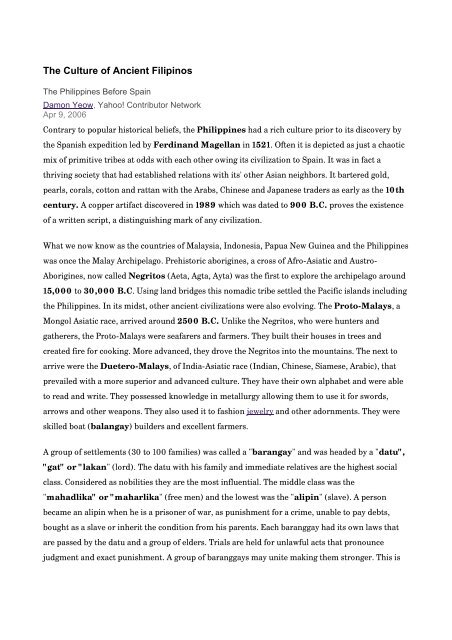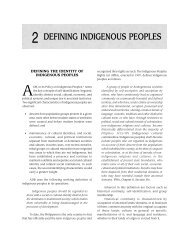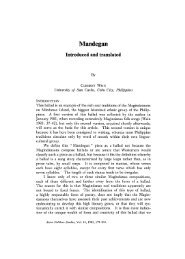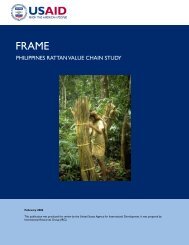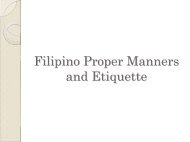The Culture of Ancient Filipinos - Philippine Culture
The Culture of Ancient Filipinos - Philippine Culture
The Culture of Ancient Filipinos - Philippine Culture
Create successful ePaper yourself
Turn your PDF publications into a flip-book with our unique Google optimized e-Paper software.
<strong>The</strong> <strong>Culture</strong> <strong>of</strong> <strong>Ancient</strong> <strong>Filipinos</strong><br />
<strong>The</strong> <strong>Philippine</strong>s Before Spain<br />
Damon Yeow, Yahoo! Contributor Network<br />
Apr 9, 2006<br />
Contrary to popular historical beliefs, the <strong>Philippine</strong>s had a rich culture prior to its discovery by<br />
the Spanish expedition led by Ferdinand Magellan in 1521. Often it is depicted as just a chaotic<br />
mix <strong>of</strong> primitive tribes at odds with each other owing its civilization to Spain. It was in fact a<br />
thriving society that had established relations with its' other Asian neighbors. It bartered gold,<br />
pearls, corals, cotton and rattan with the Arabs, Chinese and Japanese traders as early as the 10th<br />
century. A copper artifact discovered in 1989 which was dated to 900 B.C. proves the existence<br />
<strong>of</strong> a written script, a distinguishing mark <strong>of</strong> any civilization.<br />
What we now know as the countries <strong>of</strong> Malaysia, Indonesia, Papua New Guinea and the <strong>Philippine</strong>s<br />
was once the Malay Archipelago. Prehistoric aborigines, a cross <strong>of</strong> Afro-Asiatic and Austro-<br />
Aborigines, now called Negritos (Aeta, Agta, Ayta) was the first to explore the archipelago around<br />
15,000 to 30,000 B.C. Using land bridges this nomadic tribe settled the Pacific islands including<br />
the <strong>Philippine</strong>s. In its midst, other ancient civilizations were also evolving. <strong>The</strong> Proto-Malays, a<br />
Mongol Asiatic race, arrived around 2500 B.C. Unlike the Negritos, who were hunters and<br />
gatherers, the Proto-Malays were seafarers and farmers. <strong>The</strong>y built their houses in trees and<br />
created fire for cooking. More advanced, they drove the Negritos into the mountains. <strong>The</strong> next to<br />
arrive were the Duetero-Malays, <strong>of</strong> India-Asiatic race (Indian, Chinese, Siamese, Arabic), that<br />
prevailed with a more superior and advanced culture. <strong>The</strong>y have their own alphabet and were able<br />
to read and write. <strong>The</strong>y possessed knowledge in metallurgy allowing them to use it for swords,<br />
arrows and other weapons. <strong>The</strong>y also used it to fashion jewelry and other adornments. <strong>The</strong>y were<br />
skilled boat (balangay) builders and excellent farmers.<br />
A group <strong>of</strong> settlements (30 to 100 families) was called a "barangay" and was headed by a "datu",<br />
"gat" or "lakan" (lord). <strong>The</strong> datu with his family and immediate relatives are the highest social<br />
class. Considered as nobilities they are the most influential. <strong>The</strong> middle class was the<br />
"mahadlika" or "maharlika" (free men) and the lowest was the "alipin" (slave). A person<br />
became an alipin when he is a prisoner <strong>of</strong> war, as punishment for a crime, unable to pay debts,<br />
bought as a slave or inherit the condition from his parents. Each baranggay had its own laws that<br />
are passed by the datu and a group <strong>of</strong> elders. Trials are held for unlawful acts that pronounce<br />
judgment and exact punishment. A group <strong>of</strong> baranggays may unite making them stronger. This is
then headed by a "sultan" (king) usually the datu <strong>of</strong> the strongest baranggay. <strong>The</strong> sultan or datu<br />
collects taxes in the form <strong>of</strong> tribute from his constituents (money was not used).<br />
Relationships between baranggays are developed through commerce and treaties. <strong>The</strong> "Sandugo"<br />
is performed as a sign <strong>of</strong> agreement, alliance and unity. Representatives <strong>of</strong> the baranggay draw<br />
blood by wounding their arms and mixing it into a cup <strong>of</strong> "tuba" (coconut wine) that both then<br />
drink. From thereon they are blood brothers.<br />
<strong>The</strong> men wore loin cloths (akin to shorts) and short sleeved collarless shirts in different colors that<br />
state their social status, red for the datu, blue for nobles and black for the maharlikas. <strong>The</strong><br />
"putong" was a piece <strong>of</strong> cloth rolled over the head like a turban. A red putong means that the<br />
wearer has already killed a man and one with knitting means that he has killed many men. <strong>The</strong><br />
women wore "baro" (shirt) and "saya" (skirts) commonly known as "patadyong". Both were<br />
barefoot. Jewelry in the form <strong>of</strong> bracelets, rings and earrings was usually made out <strong>of</strong> gold. <strong>The</strong>y<br />
even used gold to adorn the teeth. Tattooing the body on the arms (women), chest and even the<br />
face was considered beautiful and proudly displayed. Tattoos on the <strong>Filipinos</strong> were so common that<br />
the Spaniards upon seeing them dubbed the islands "La Isla de los Pintados" (island <strong>of</strong> the<br />
painted ones).<br />
Houses were raised above ground and are made out <strong>of</strong> bamboo and rattan ideal for the warm<br />
tropical climate. Inside the "silid" (sleeping areas) is the "banig" (weaved sleeping mats) and<br />
pillows. <strong>The</strong> "batalan" serves as a sink to clean and wash plates and pots. Beneath the house is an<br />
enclosed space to raise chickens and <strong>of</strong>ten used as a place for beating grain. <strong>The</strong> "Kalingga" and<br />
"Ilonggot" <strong>of</strong> Northern Luzon build houses on top <strong>of</strong> trees as do the "Bagobo" and "Mandaya" <strong>of</strong><br />
Mindanao. <strong>The</strong> "Badjaos" live entirely on their boats.<br />
Unlike their western counterparts and other asian brothers, ancient Filipino society treated their<br />
women equally. <strong>The</strong>y own property, inherit from their parents/relatives, engage in trade and even<br />
head the baranggay if there is no rightful male heir. Men treat women with care, walking behind<br />
them to act as protectors.<br />
Courtship was done through a series <strong>of</strong> trials imposed on the suitor by the parents <strong>of</strong> the girl<br />
usually in the form <strong>of</strong> servitude. This may last from a few months to even an entire year. During<br />
this time the suitor chops wood, draws water, etc. to prove his serious intentions, commitment and<br />
affection. <strong>The</strong>y are not allowed to talk to each other. If the parents are satisfied they will ask a
"dote" (dowry) from the suitor usually land, gold and other valuables. It is encouraged that<br />
individuals marry into their class but marriage between different classes is not forbidden. Marriage<br />
rituals are <strong>of</strong>ficiated by a "babaylan" or "catalonan" (priest) who also performs burial rites for<br />
the dead.<br />
<strong>The</strong>y believe in the "Bathalang Maykapal" (supreme being) or "Dakilang Lumikha" (ultimate<br />
creator) and the existence <strong>of</strong> the eternal soul. <strong>The</strong>y also believe in other deities, environmental and<br />
ancestral spirits with which they <strong>of</strong>fered gifts and sacrifices. Prayers are made as thanks or to<br />
ensure a good harvest, catch or journey.<br />
<strong>The</strong>irs was a culture rich in its own beliefs and practices. <strong>The</strong>y enjoyed the arts and expressed it<br />
through music and dance. Far from being uncivilized, the ancient <strong>Filipinos</strong> had a unique identity at<br />
par with any <strong>of</strong> it's time.<br />
Ref.: http://voices.yahoo.com/the-culture-ancient-filipinos-29764.html


